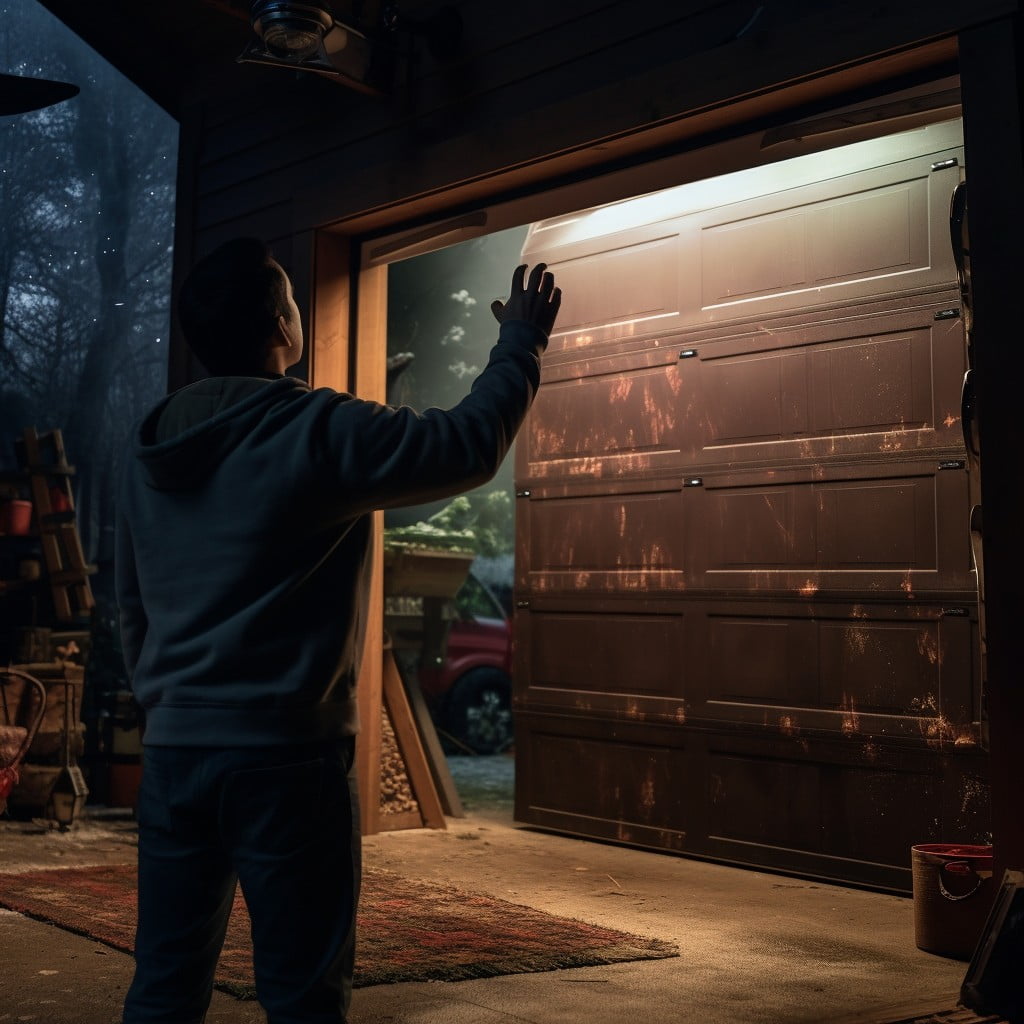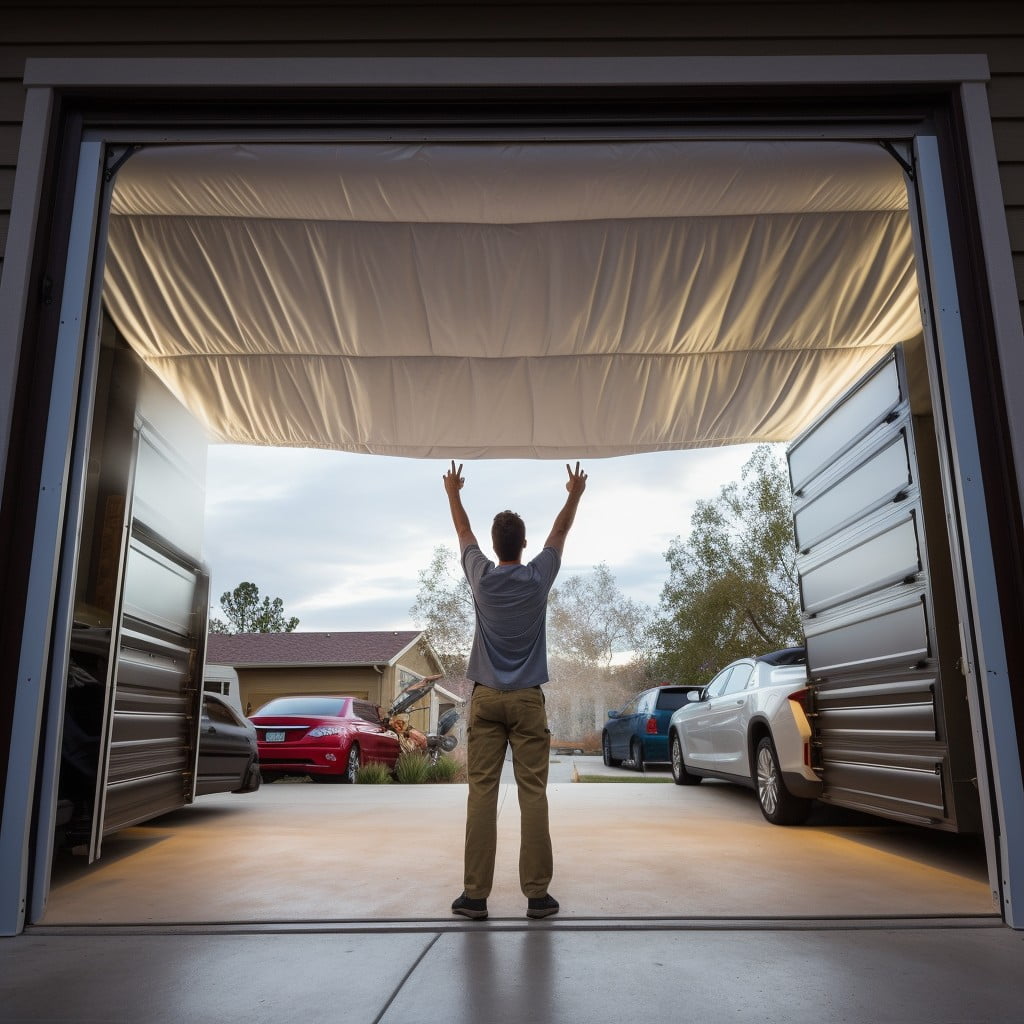Discover the simple steps to successfully open your garage door from the outside, even during power outages or if you’ve misplaced your remote control.
Finding yourself locked out of your garage can be a frustrating experience, but don’t worry, there are some simple steps you can follow to open your garage door from the outside. This article will guide you through the process, whether your garage is equipped with an emergency release cord or not.
We’ll also cover some preventative measures to ensure you’re never locked out again. So, whether you’re dealing with a power outage, a lost remote, or a malfunctioning garage door opener, keep reading for a comprehensive solution to your problem.
Key takeaways:
- Understand the emergency release cord and how to use it.
- Follow step-by-step instructions for manually opening the garage door from the outside.
- Know how to open the garage door during a power outage.
- Take safety precautions when manually operating the garage door.
- Minimize the need for manual operation by maintaining the garage door.
Understanding the Emergency Release Cord

The Emergency Release Cord serves as an essential component of your garage door system. Typically, it hangs from the center track of your garage door mechanism and is visually identifiable by a red handle. This device is your primary tool when you need to manually override the automatic operation of your door.
In power outage scenarios, understanding its functionality becomes invaluable for a smooth, safe operation. Your garage door runs on a high-tension spring system which is inherently hazardous to mishandle, so taking due care is imperative. However, the release cord acts as a bypass to this system, enabling manual control with comparative ease.
Most importantly, you should only activate the release cord when the garage door is in the closed position. Since it frees the door from the automatic system, operating the cord when the door is open may cause it to crash down due to the weight.
Understanding the placement and function of the Emergency Release Cord is fundamental to competently and safely operating your garage door manually from either the inside or outside. Thus, it’s an asset in unexpected power failures or any other situation wherein your garage door opener fails to function.
How to Manually Open the Garage Door From the Outside

To manually open a garage door from the outside, start by locating the emergency release kit. This will typically be a small, key-operated switch installed on the door casing or nearby wall. Once found, insert the release key and turn it to disengage the opener’s lock, thus enabling manual operation.
Ensure you have a firm grip on the door handle before proceeding, as garage doors can be heavy. Slowly lift the door. It should open relatively easily. If there’s resistance, check for obstructions or damage that might be causing the issue. Do not force the door if it won’t budge; professional assistance may be needed to avoid causing further damage.
Important caution: Avoid using this manual method excessively to deter wear and tear. It’s primarily designed for emergencies or power outage situations. Always remember to engage the lock again after closing the door, to maintain the security of your garage.
Step-by-Step Guide to Open Your Garage Door During a Power Outage

To successfully navigate a power outage and still gain access to your garage, consider these practical steps:
1. Locate the emergency release cord: Inspect your garage door system and find the cord, generally labeled with a red handle. This cord hangs from the center rail of the garage door system and is directly linked to the trolley.
2. Pull the emergency release cord: Ensure your garage door is fully closed, then carefully disengage your garage door opener by pulling the cord. Now your door is in manual mode.
3. Lift the garage door: Stand with your feet apart for balance and use both hands to lift the garage door. The panels should roll smoothly along the tracks as you push upward. If there’s resistance, cease immediate action and solicit the assistance of a professional to avoid damage or injury.
4. Secure the door: After it’s open, firmly prop the door in place. In manual mode, the door won’t stay up on its own and could be hazardous if not secured properly.
5. To close the door, carefully pull it down and manually lock it: Your electric opener does this for you normally, but in manual mode, you’ll need to lock it yourself to ensure the door stays closed.
Remember, safety is of utmost concern when manually operating your garage door. If any aspect feels dangerous or overwhelming, don’t hesitate to call a professional for aid.
Opening the Garage Door From the Inside

Initiating the manual release mechanism is the first crucial step. This mechanism, usually a red cord hanging from the garage door opener, disconnects the door from the powered opening system. Ensure the garage door is fully down before disengaging to prevent any possible injuries.
Following this, locate the garage door’s handle or grab bar. Lift it upwards to roll the door along its tracks. Since the door is heavy, employing a level of caution can prevent any mishaps. If the door feels unusually heavy or jammed, refrain from forcing it and look into possible blockages or damages in the track.
Always remember that, for the safety and functionality of the garage door, reconnect the door to the opener once you’re able to restore power. This will enable normal operation through the remote control or wall switch.
Opening the Garage Door From the Outside
Firstly, locate the emergency release kit, a small box mounted near the top of your garage door. This usually contains a locking mechanism and an accompanying key uniquely designed for your door model. To open the door, insert the key, turn it, and pull the lock tumbler out, activating the manual override of the opener system.
Next, move closer to the door. Standing behind it, lift it manually. Remember, depending on the door’s design and weight, you might require more force than anticipated, and in some cases, it may be a two-person job.
Finally, prop up the door using either your garage door’s built-in prop or your own materials, such as a length of 2×4 wood. This ensures the door stays open and safe while you’re moving in and out.
Throughout this process, safety should be your priority. Always remember to remove the key from the lock after the tumbler is pulled out and keep it in a secure place. Avoid standing underneath the door while lifting it to minimize the risk of injury.
Safety Tips for Manually Opening Your Garage Door
Here’s a critical aspect – as you prepare to manually open your garage door, safety should always be paramount.
First, ensure you have the right personal protective gear, such as gloves and sturdy footwear, to protect against potential injury. Garage doors can be heavy and if not handled correctly, might lead to injuries.
Second, make sure that the garage door is fully closed before you disengage the garage door opener. An open door might crash down, causing damage or injury.
Third, be aware of the location of all parts and mechanisms involved in the process. For instance, the emergency release cord, usually red, is crucial in this process.
Lastly, never allow children to perform this task. They may not appreciate the risks involved. Remember, safety comes first and these measures will help prevent accidents during the process.
How to Open Garage When Power Is Out From Outside
Finding yourself locked out during a power outage can be an inconvenience. However, there are ways to gain access. First, locate the emergency release kit on the garage door’s exterior; You’d typically find it near the top middle. Make use of your key to unlock it, revealing a cable. Pull this cable down and away from the door, disengaging the garage door opener, and allowing for manual operation.
Finally, heave the garage door upwards. It should stay in place once completely open. If it does not, ensure caution as a sudden drop can lead to injuries. Remember, this method becomes void if your garage door doesn’t have an external emergency release kit. In that case, seeking help from a professional locksmith or garage door technician is advisable.
Resetting the Garage Door Opener
Once the power is restored or you’ve been able to access your garage from the outside, it’s essential to reset the garage door opener. This step helps ensure that the automated system resumes its normal function, thereby eliminating the need for manual operation. To do this:
1. Check your garage door opener. Some models may need to be reconnected manually. Refer to your device’s manual for specific instructions.
2. Press the button on your remote. This is typically the quickest way to determine if your garage door opener needs resetting.
3. If pressing the button doesn’t successfully open the door, look for a reset button on the back of your garage door motor unit. Press it and then try the remote again.
4. If your door still isn’t responding, you might need to reprogram the remote. This usually involves holding down a programming button on the motor unit while simultaneously pressing a button on the remote.
5. Finally, confirm that other garage door parts are in good condition and not causing any mechanical issues with the opener, such as misaligned tracks or a worn-out garage door spring.
Reconnecting the Garage Door After the Power Is Restored
Once power returns, you’ll need to reconnect the garage door opener to the door. Follow the steps outlined below for a smooth and efficient process:
1. Begin by securing the door. It should be in the down position to prevent any accidents.
2. Locate the emergency release cord. This is typically a red rope hanging from the garage door opener track.
3. To re-engage the trolley, pull down the emergency release cord towards the door. Pulling the cord in this direction allows for quicker and easier reconnection.
4. Manually lift the garage door until it reaches the top. You’ll know you’ve done it correctly when you hear a click indicating the trolley has reconnected.
Remember, the garage door opener will not work properly unless it’s reconnected in the correct manner. If you experience any difficulties during this process, it’s advisable to consult with a professional to prevent any damage to your garage door system.
Call for Professional Help
While some instances of a stuck garage door might call for a simple DIY solution, there are situations that require expert attention. If you observe damage on the springs or cables, or the door is off its tracks, it’s time to halt your attempts and dial a professional’s number.
In addition to preventing potential injuries and further damage, professionals are equipped with technical skills, specialized tools, and vast experience that guarantees a quick, efficient job. They can easily track the root cause of the problem, apply the correct fix, and ensure the door functions optimally. Furthermore, they can provide essential maintenance tips and possible upgrades to minimize future occurrences.
Remember, if your garage door won’t open, and the troubleshooting tips have failed, it’s not a sign of defeat to call a garage door professional. Ensuring your safety and that of your property must always come first.
How to Minimize Opening the Garage Door Manually
Maintaining your garage door periodically is key to reducing the need for manual operation. Here are some points to consider:
1. Regular Servicing: Engage professionals to inspect your garage door system every 6-12 months. They check for wear and tear, ensure the engineering components are functioning smoothly and can spot potential problems before they become significant issues.
2. Lubrication: Keep the moving parts of your garage door well-lubricated to reduce stress on the motor and ensure smooth operation.
3. Quality Parts: Invest in high-quality garage door parts. While they might be slightly more expensive initially, they pay off in the long run with a lower frequency of breakdowns.
4. Power Backup: Consider installing a battery backup for your electric garage door opener. This ensures your garage door can still be operated electrically during power outages.
5. Avoid DIY Repairs: Unless you’re an expert, do not attempt to repair or adjust the garage door components yourself. Amateur repairs can lead to more harm than good and might necessitate manual operation more often.
With these simple steps, you can keep your garage door operating optimally and reduce the necessity of manual opening.
The Role of the Garage Door Key
A garage door key serves as an alternative access route apart from the standard electronic opening mechanism. Primarily used in instances of power outages or remote control failure, the garage door key works on the lock cylinder located outside your garage.
To utilize your garage door key, insert it into the designated lock, ensuring it turns the tumbler, which subsequently triggers the manual release mechanism. This will allow you to lift the door manually. Also, note that some modern garages come with a wireless keypad system. For these cases, the key is in the form of a secret code you input for manual access.
Remember, it’s essential to keep your key in a secured and easily accessible place. Having it within reach can save you a lot of stress, especially during unexpected electricity outages. Additionally, for security reasons, do not share your key or secret code with unfamiliar people.
Understanding Why Garage Doors Get Stuck
Various factors could make a garage door stuck and unable to open. Firstly, it could be due to bad lubrication. Over time, the door tracks and rollers may not be as smooth as they once were, making it hard to move. Regularly applying an appropriate lubricant can help alleviate this issue.
Secondly, worn-out springs could be another factor. Springs are neutral when the door is closed, but when the door is opened, the springs get wound up. Over time, the tension in the springs subsides and they wear out, making it harder to open the garage door.
Thirdly, the door could be stuck because of a blocked path. If anything blocks the door’s path, it will not open. Regularly inspecting the door’s path can help prevent this from happening.
Last**l**y, a misaligned track could be the cause. The door moves on a track and when it is misaligned, the door may fail to open. Regular adjustments and checks can keep the track aligned.
However, if the door’s stuck, immediate and professional help is often the best solution to protect your safety and maintain the optimal performance of your garage door.
FAQ
Is it possible to open a garage door from the outside?
Yes, it is possible to open a garage door from the outside unless it is locked.
How do you open a garage door from the outside without a key?
To open a garage door from the outside without a key, you can utilize a diamond pick and an L-key, inserting the L-key at the bottom of the lock hold, the diamond pick at the top, and moving it to lift the tumblers which should cause the lock to rotate, allowing you to open the door.
What tools are required to manually open a garage door from the outside?
To manually open a garage door from the outside, you would need a flathead screwdriver and a sturdy wire or coat hanger.
Are there specific methods for different types of garage doors when opening from the outside?
Yes, different garage door types—manual, automatic, or smart garage doors—require different methods for external opening, such as the use of keys, remotes, keypad codes, or mobile apps respectively.
Are there security risks associated with opening a garage door from the outside?
Yes, opening a garage door from the outside can pose security risks as it provides potential access points for burglars.